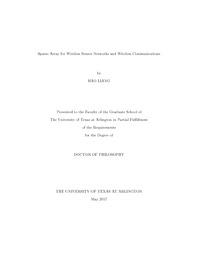
ATTENTION: The works hosted here are being migrated to a new repository that will consolidate resources, improve discoverability, and better show UTA's research impact on the global community. We will update authors as the migration progresses. Please see MavMatrix for more information.
Show simple item record
| dc.contributor.advisor | Liang, Qilian | |
| dc.creator | Liang, Hao | |
| dc.date.accessioned | 2017-07-03T14:07:45Z | |
| dc.date.available | 2017-07-03T14:07:45Z | |
| dc.date.created | 2017-05 | |
| dc.date.issued | 2017-05-11 | |
| dc.date.submitted | May 2017 | |
| dc.identifier.uri | http://hdl.handle.net/10106/26761 | |
| dc.description.abstract | Underwater target detection and recognition has been widely used nowadays. In this dissertation, we show that the 3-D nested-array system can provide O(N^2) degree of freedom by using only N physical sensors when the second order statistics of the received data is used, which means we can use less sensors to get a better performance. We propose a maximum likelihood (ML) estimation algorithm for underwater target size detection. Theoretical analysis illustrates that our underwater sensor network can tremendously reduce the variance of target estimation. We show that our ML estimator is unbiased and the variance of parameter estimation matches the Cramer-Rao lower bound.We also propose a maximum likelihood automatic target recognition (ML-ATR) algorithm for nonfluctuating as well as fluctuating targets. Theoretical analysis illustrates that our underwater ML-ATR method can tremendously reduce the number of physical sensors while maintain in a good performance
Moreover, a novel deployment for multi-cell cooperative cellular network based on the two-dimensional (2D) coprime array, and analysis on its sum rate capacity are proposed. Taking advantage of that the 2D coprime-array system can provide O(N^2) degree of freedom by using only N physical sensors when the second order statistics of the received data is used, we show that the derivation
procedure of average sum-rate capacity for the cooperative cellular network is still valid for the coprimed distributed base stations (BSs) in the non-fading and Rayleigh fading channels.
We also study sense-through-foliage target detection using ultra-wideband (UWB) radars. We propose a Discrete-Cosine-Transform (DCT)-based approach for sense-through- foliage target detection when the echo signal quality is good, and a Radar Sensor Network (RSN) and DCT-based approach when the echo signal quality is poor. A RAKE structure which can combine the echoes from different cluster-members is proposed for clusterhead in the RSN. We compared our approach with the ideal case when both echoes are available, i.e., echoes with target and without target. We also compared our approach against the scheme in which 2- D image was created via adding voltages with the appropriate time offset as well as the matched filter-based approach. We observed that the matched filter-based could not work well because the UWB channel has memory.
In the last Chapter, we propose a transfer entropy based approach for sense-through-foliage target detection. It is the first time to apply Transfer Entropy(TE) to real world target detection. Two different types of data are provided by Air Force Office of Scientific Research in terms of radar echo signal quality. We compare our approach with the case of linear regression approach for target detection. Simulation results show that our scheme works better than the existing approaches. | |
| dc.format.mimetype | application/pdf | |
| dc.language.iso | en_US | |
| dc.subject | Sparse array | |
| dc.subject | Wireless sensor network | |
| dc.title | Sparse Array for Wireless Sensor Networks and Wireless Communications | |
| dc.type | Thesis | |
| dc.degree.department | Electrical Engineering | |
| dc.degree.name | Doctor of Philosophy in Electrical Engineering | |
| dc.date.updated | 2017-07-03T14:07:45Z | |
| thesis.degree.department | Electrical Engineering | |
| thesis.degree.grantor | The University of Texas at Arlington | |
| thesis.degree.level | Doctoral | |
| thesis.degree.name | Doctor of Philosophy in Electrical Engineering | |
| dc.type.material | text | |
Files in this item
- Name:
- LIANG-DISSERTATION-2017.pdf
- Size:
- 1.686Mb
- Format:
- PDF
This item appears in the following Collection(s)
Show simple item record


